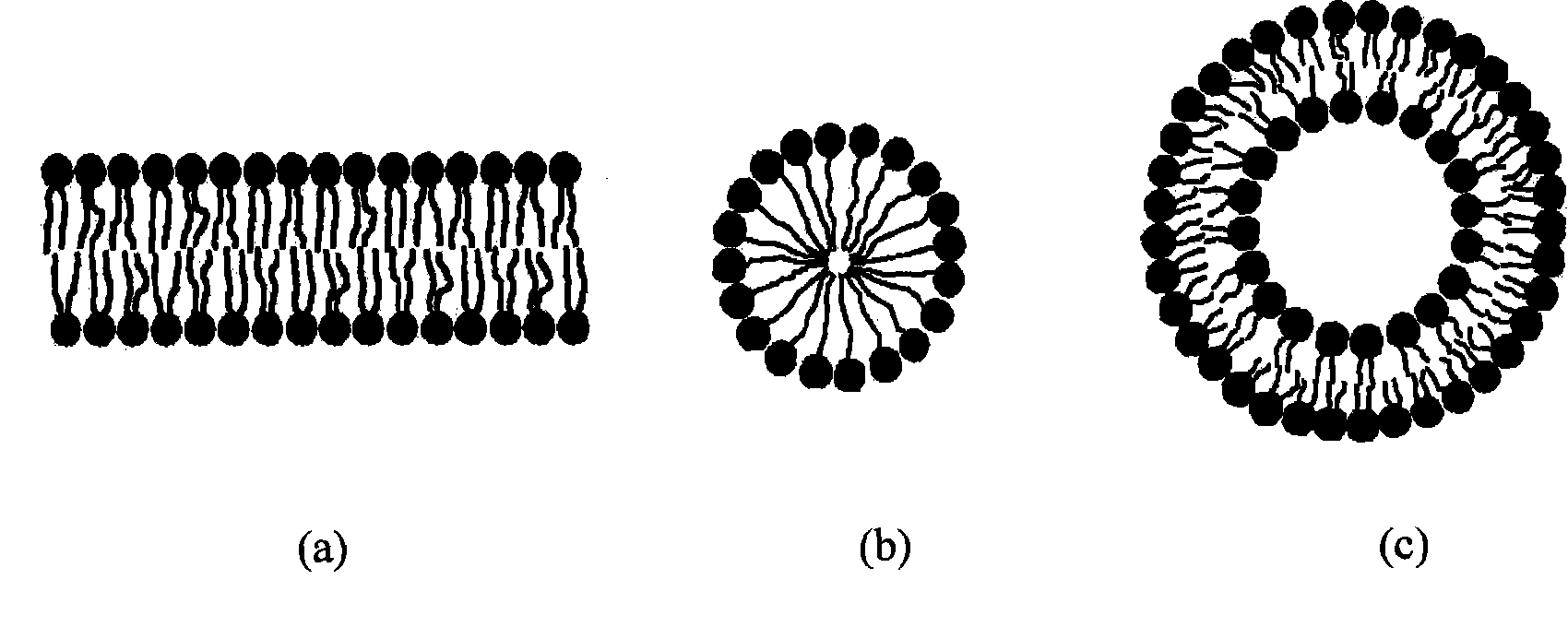Preparation of self-assembly bionic phospholipid polyalcohol organization plasmalemma and application thereof
A bionic phospholipid and polymer technology, applied in medical science, prosthesis, surgery, etc., can solve problems such as high cost, high degree of model automation, and inconvenient testing
- Summary
- Abstract
- Description
- Claims
- Application Information
AI Technical Summary
Problems solved by technology
Method used
Image
Examples
Embodiment 1
[0037] Accurately weigh 28.76g (0.197mol) of 1,8-octanediol, Et 3 N33.1g (0.327mol) was dissolved in 200mL of dry THF, cooled to 0°C, and 20.6g (0.197mol) of methacryloyl chloride was slowly added dropwise with stirring, keeping the temperature at 0°C, and the mixture was heated to 50°C for 2 hours. After filtering, washing, and column separation, a colorless liquid octylene glycol methacrylate was obtained, and the developing solvent was EtOAc / hexanes 20 / 80. Accurately weigh octylene glycol methacrylate 32.96g (0.154mol), 15.6gEt 3 Dissolve N (0.154mol) in 200mL dry THF, cool to -20°C, dissolve 21.9g (0.154mol) COP in 100mL dry THF, stir and slowly add the solution dropwise, keep the temperature at -20~-30°C for 3h , filtered, washed, and dried to obtain 2-(2-oxo-1,3,2-dioxaphospholoyloxy)ethyl methacrylate as a colorless liquid. Accurately weigh 5.0g of 2-(2-oxo-1,3,2-dioxaphospholoyloxy)ethyl methacrylate and 30ml of dry acetonitrile, cool to -20°C, quickly add 2ml of anh...
Embodiment 2
[0039] Accurately weigh 1,9-nonanediol 31.52g (0.197mol), Et3 N33.1g (0.327mol) was dissolved in 200mL of dry THF, cooled to 0°C, and 20.6g (0.197mol) of methacryloyl chloride was slowly added dropwise with stirring, keeping the temperature at 0°C, and the mixture was heated to 50°C for 2 hours. After filtering, washing, and column separation, a colorless liquid octylene glycol methacrylate was obtained, and the developing solvent was EtOAc / hexanes 20 / 80. Accurately weigh octylene glycol methacrylate 34.25g (0.154mol), 15.6gEt 3 Dissolve N (0.154mol) in 200mL dry THF, cool to -20°C, dissolve 21.9g (0.154mol) COP in 100mL dry THF, stir and slowly add the solution dropwise, keep the temperature at -20~-30°C for 3h , filtered, washed, and dried to obtain 2-(2-oxo-1,3,2-dioxaphospholoyloxy)ethyl methacrylate as a colorless liquid. Accurately weigh 5.0g of 2-(2-oxo-1,3,2-dioxaphospholoyloxy)ethyl methacrylate and 30ml of dry acetonitrile, cool to -20°C, quickly add 2ml of anhydrou...
Embodiment 3
[0041] A small amount of synthetic lecithin polymer is placed on the micropores of PAMPA. PAMPA consists of upper and lower chambers. The upper layer is the donor fluid (buffer solution and drug), and the lower layer is the receiving fluid (buffer solution). The buffer solution consists of 50mM Sodium phosphate (pH6.0-7.5), 50mM sodium citrate (pH3.0-5.5), 50mM sodium borate (pH8.0-10.0), cultured at 30°C for 2-15 hours to form lecithin polymer biomimetic cell membrane. The concentration of the solution in the receiver was measured by UV spectroscopy. The penetration rates of several drugs such as sulfamethoxidine, Norfolk, hydrochlorothiazide, ritrolidine, propranolol, and verapamil were 16.0, 45.0, 16.0, 128.0, 133.0, and 148.0 nm / s in a small amount of tests.
PUM
| Property | Measurement | Unit |
|---|---|---|
| glass transition temperature | aaaaa | aaaaa |
| thickness | aaaaa | aaaaa |
| contact angle | aaaaa | aaaaa |
Abstract
Description
Claims
Application Information
 Login to View More
Login to View More - R&D
- Intellectual Property
- Life Sciences
- Materials
- Tech Scout
- Unparalleled Data Quality
- Higher Quality Content
- 60% Fewer Hallucinations
Browse by: Latest US Patents, China's latest patents, Technical Efficacy Thesaurus, Application Domain, Technology Topic, Popular Technical Reports.
© 2025 PatSnap. All rights reserved.Legal|Privacy policy|Modern Slavery Act Transparency Statement|Sitemap|About US| Contact US: help@patsnap.com



